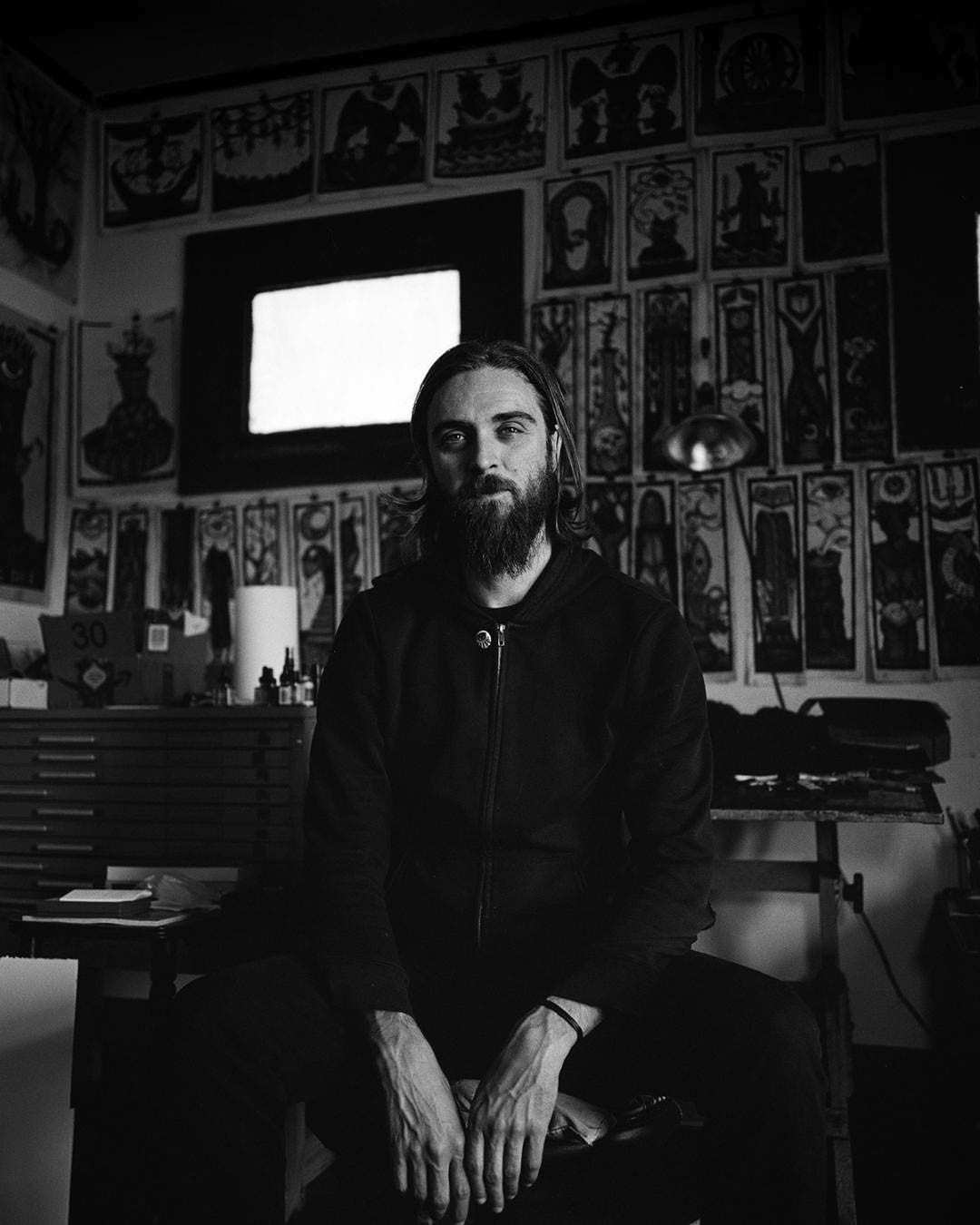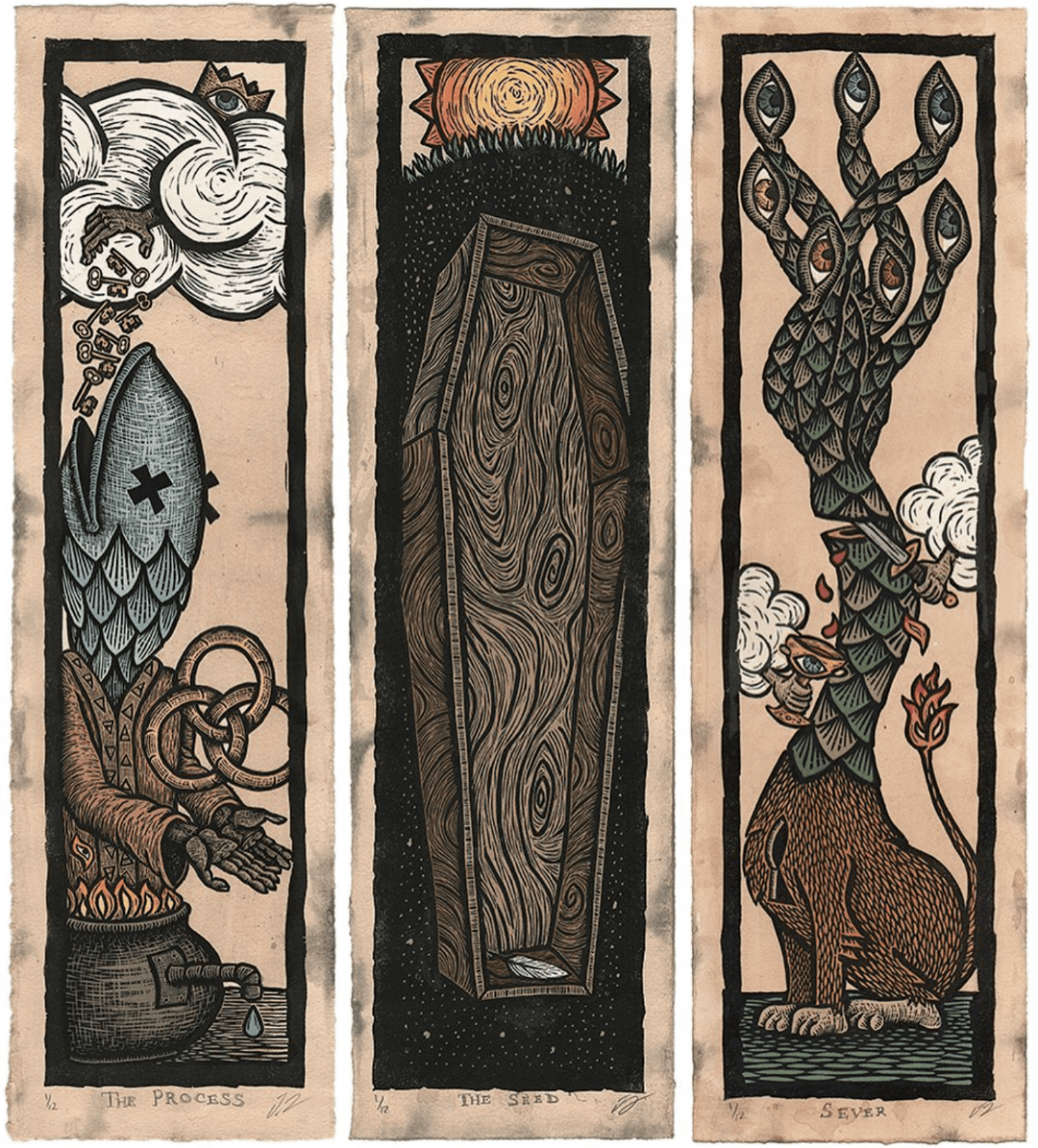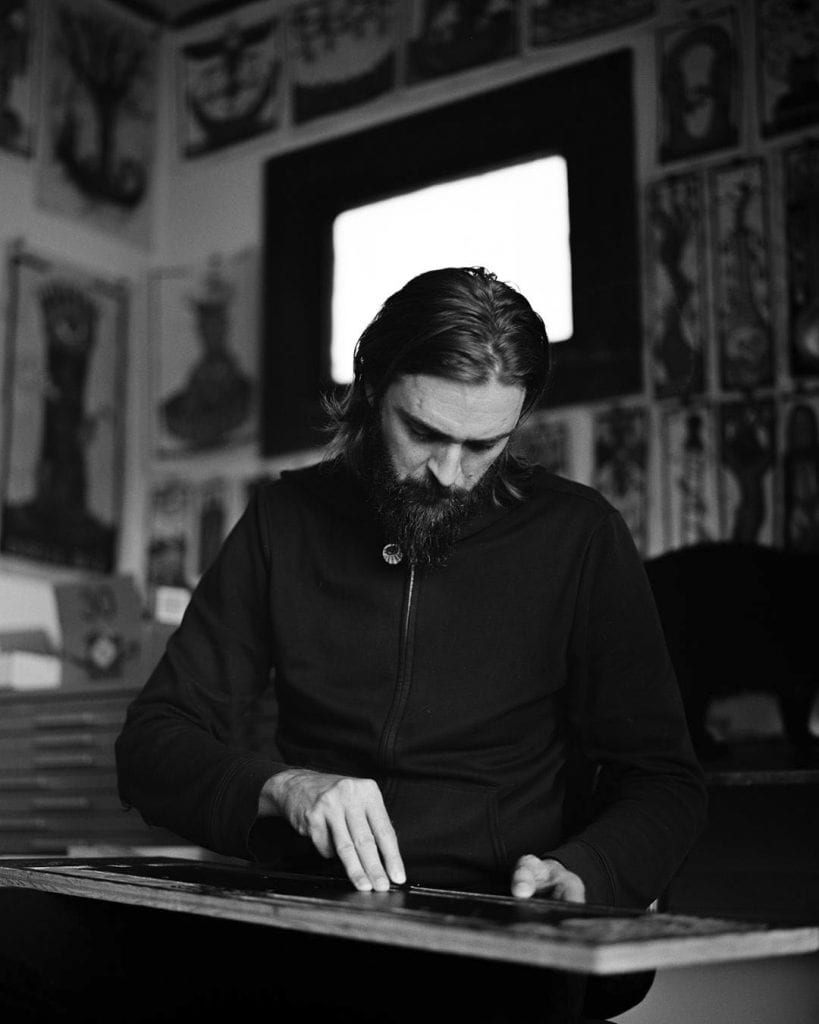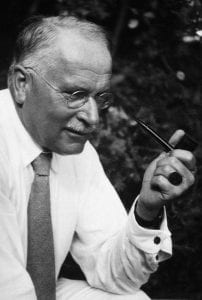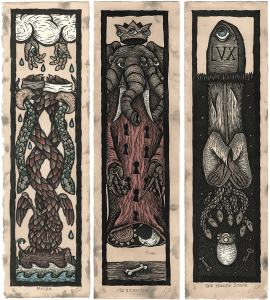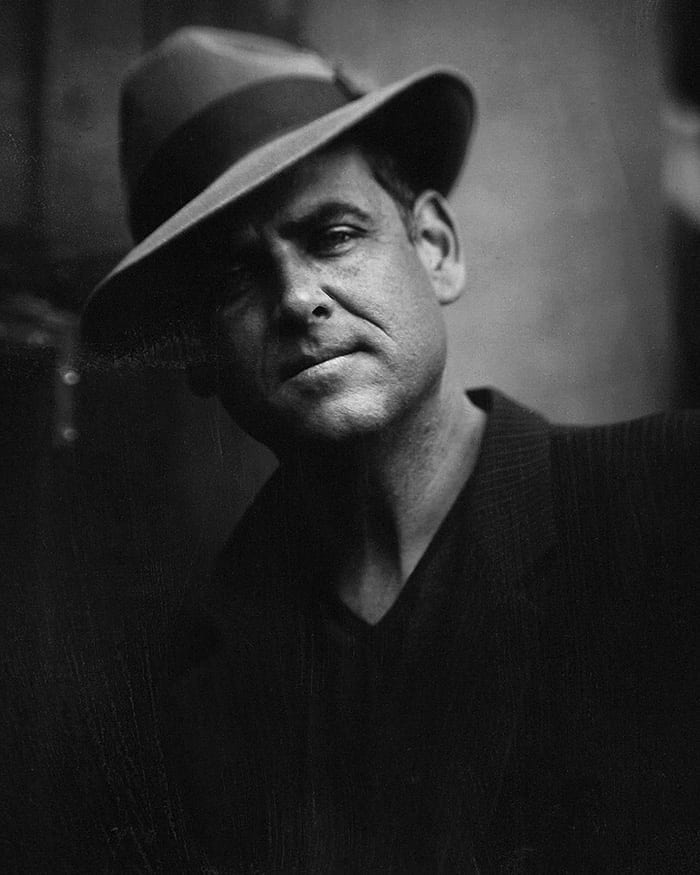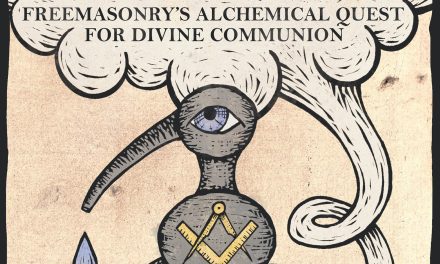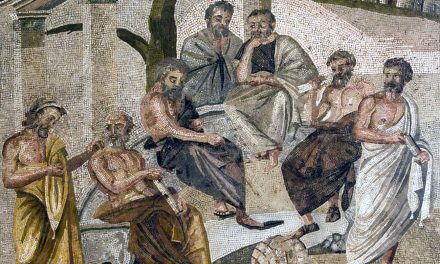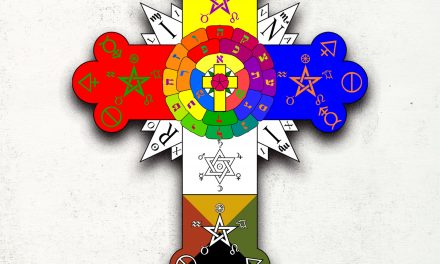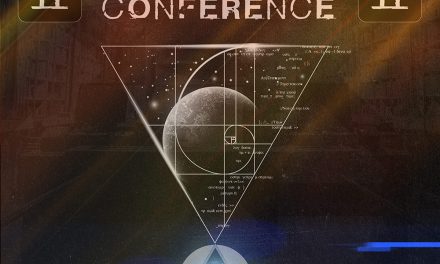Art of the Esoteric: A Conversation with Printmaker Travis Lawrence
Artist Travis Lawrence of Infinity Prints creates allegorical imagery influenced by mythology, Jungian psychology, Hermeticism and medieval woodcuts. His artwork is made by hand, carving his images into a solid surface and printing them onto paper.
One of his images is featured on the cover of Tria Prima’s first book printing, P.D. Newman’s Angels in Vermilion: The Philosophers’ Stone from Dee to DMT.
Lawrence spoke with us via video chat about the cover image, Western Esotericism, angels and the influence Carl Jung’s work has had on his life and personal philosophy.
He became a Freemason in 2013. His mother lodge is Gateway #40 in St. Louis, Missouri.
Edited for space and clarity.
Tell me about your art?
My primary focus is printmaking–relief printmaking is the specific focus within there. The go-to reference of that would be the classic wood cut style, because that’s how the process works–carving blocks or a material and then printing it on usually paper.
I’m heavily influenced by a lot of medieval imagery, the classic woodcut. That’s been a big visual influence for me, but it also kind of relates to the content in the classic hermetic ideas.
I’m taking that aesthetic and those ideas and giving it my own personal voice.
How did you find your way to these ideas and topics?
I grew up in the typical Midwestern Christian upbringing. By the time I was 20, I was already starting to dive into different religions and different philosophies. And shortly after I got into a lot of the teachings of Carl Jung who really helped introduce me to alchemy, Gnosticism and that kind of branched into things like Hermeticism.
I was already aware of these ideas as I was growing and maturing and coming into printmaking, where there is this classic art form that I also was diving into that work in it’s early stages.
The two worlds collided for me.
Freemasonry and the Western Esoteric Tradition have so many rich symbols. Is there one you continue to be drawn to? Is there anything that keeps showing up in your work?
Years ago I realized I was doing all of these birds, like the feathers. At first I thought I was really doing it because I wanted the challenge of the feathers. They’re not easy to carve. Before you know it, I had just a ton of these odd eagle-owl-type-things. I started to realized I was creating my own too. There were a bunch of these that sort of look like owls, and I think initially that’s kind of what I was going for, especially because you know, the owl has a very prominent role even in esotericism because it’s one of the liminal creatures that reside in both realms. They’ve also got this funny role in modern day like, alien abductions as well. They date back all the way to these ancient philosophies of being these watchers between the waking world and the dead.
So it was a mix of these owls and then it was also this Phoenix reference to them as well. So I found myself creating my own mythical bird creature that was a conglomerate of these different ideas of these bird-type qualities.
You designed the cover for Tria Prima’s first book printing, Angel’s in Vermillion by P.D. Newman. The cover has a feathered creature on the cover. Tell us about that creature on the cover.
It’s a personal take on the Seraphim. I think it’s in Isaiah it speaks about the Seraphim and gives a description of them. They even hid their faces because they are this top-tier form of angelical hierarchy. They’re these transcendental forms of wings and eyes. Their faces are hiding and they’re calling out “Holy, Holy, Holy.”
In the year that King Uzziah died, I saw the Lord sitting on a throne, high and lifted up, and the train of His robe filled the temple. Above him stood the seraphim. Each had six wings: with two he covered his face, and with two he covered his feet, and with two he flew. And one called to another and said:
- “Holy, holy, holy is the Lord of hosts;
- the whole earth is full of his glory!”
- Isaiah 6: 2-6
The idea of these magnificent angelic forms is way beyond whatever our concept of what angels are.
There was this guy Pseudo-Dionysius who created a hierarchy list of the angelic forms and the ones that actually have any kind of human features are on the bottom tier. That’s the archangels. I think the top is the Seraphim, then you have the Thrones and the Cherubim. The idea of angels we have in the modern day is kind of like the foot workers. This is my take on this high angelic from.
The work of Carl Jung has a big influence on you. Why?
Jung does a really good job at helping you understand Why.
For me as someone that was coming from a Christian upbringing, and got to that rebellious age where that wasn’t necessarily working for me and answering all the questions, I was out looking for all these other answers and I was looking to Eastern thought and Eastern religion. Those really didn’t do anything for me either. It definitely helped bring in some some new philosophies and different ways of approaching it, but it’s a different culture. My brain doesn’t really work that way. I mean, I can understand it from an academic perspective, but I still was so ingrained in the western language which has been for 1000s of years influenced by the Abrahamic philosophies. That’s the language that I spoke.
Getting into Jung, outside of even him just introducing me to things like Gnosticism and alchemy, he really introduces you into how the actual symbolic language works within mythology, and what kind of relationship you’re having when you are practicing each religion. He kind of helped me understand a lot of the questions that I had about my religion, that wasn’t satisfying me at a younger age.
And as I got older and was able to study and re-approach it, it really helped me appreciate what I was brought up in and why this religion works, the elements of it, and what parts of it to focus on as well as other religions and philosophies that have influenced from it. Especially the last couple hundred years where the western mind has become so very science focused, and very material base. There has been a loss of spirit from living, really.
We’re definitely becoming more of a materialistic, almost nihilistic-type-species. And a lot of that’s because of our swaying away from religion, more dependency on science based thinking. But there’s still something that we need as humans, and it’s that spiritual element.
Even if religion doesn’t make as much sense now in a literal manner, and with historical contradiction, there’s still a heavy element of truth that’s still in there.
You have to understand it in a mythological form of thinking, which is a similar way as the way poets write. It’s the same thing that artists do whenever they’re making work.
He helped bridge that for me and put words into my mind or into my mouth that I wasn’t yet at an age or mature enough really to formalize that yet.
FROM TRIA PRIMA PUBLISHING
Once considered the “Holy Grail” of hallucinogens, over the last quarter century, DMT has entered the public mind like never before. No longer a taboo topic to be discussed in the hushed tones among an esoteric elite, P.D. Newman’s Angels In Vermillion traces the secret lineage of transmission, beginning with Elizabethan alchemists, Dr. John Dee and Sir Edward Kelley, winding through the Royal Society and Masonic fraternity, and leading all the way up to the nineteenth century occult revival – and beyond.
